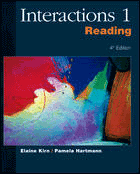 |  Interactions 1 Reading, 4e Elaine Kirn,
West Los Angeles College
Pamela Hartmann,
Los Angeles Unified School District
Use of English and Native Language in the Classroom A. Encouraging Your Students to Use English
One of the best ways to encourage your students to use English is to use it yourself from the very first class. With beginning classes, supplement English with other nonlinguistic messages.
- Use gestures.
- Act out what you are saying as you are saying it.
- Write a crucial word on the board if you think that students may recognize it.
- Prompt students with pictures and illustrations posted around the room.
- Say, "Excuse me, I don't understand you" when students speak to you in their native language and you are certain that they could actually say the same thing in English.
- When students speak to you in their native language, give them the sentence or question in English and have them repeat it.
- Do not always insist on accuracy. Students will be more encouraged to speak if they know that it's okay to make mistakes.
- Speak to students in English as much as possible outside of class.
- Keep English–English dictionaries (picture dictionaries at the lower levels) in the class to encourage students to look words up.
- Teach lower-level classes the classroom language they will need and then encourage them to use it.
B. Using Native Language in the English Classroom
There are times when it is appropriate to use students' native language in the classroom.
- Use students' native language for a quick translation of a word or phrase in order to eliminate nonproductive minutes of frustration on the part of students and teacher. However, don’t let translation become a crutch.
- When you are giving important directions, such as for a test, do a quick comprehension check and translate if necessary.
- If you are a competent speaker of your students' native language, do not try to counsel students in English. Trying to talk about problems in English may only increase their distress because they will have difficulty expressing their feelings.
|
|



 2002 McGraw-Hill Higher Education
2002 McGraw-Hill Higher Education